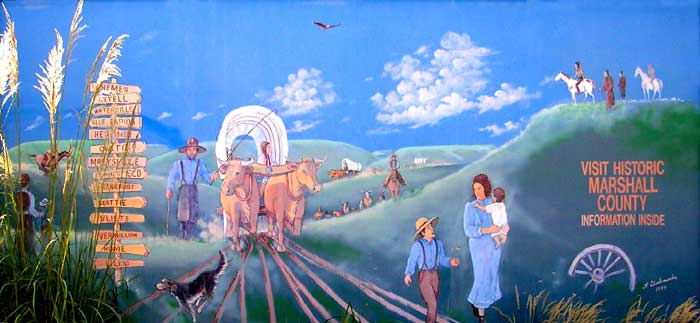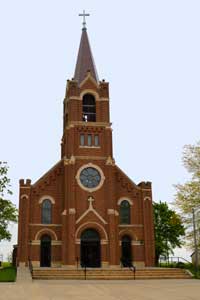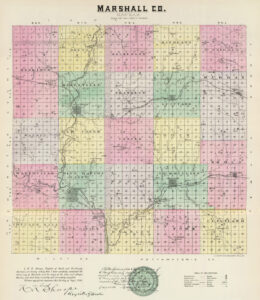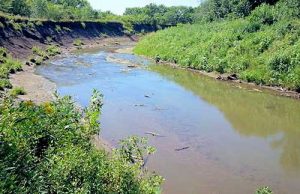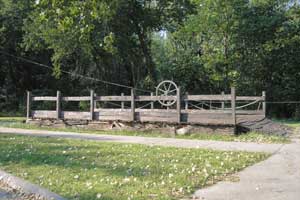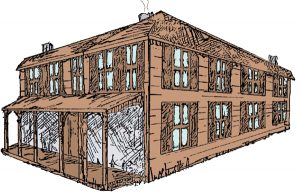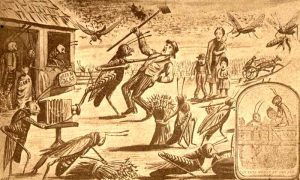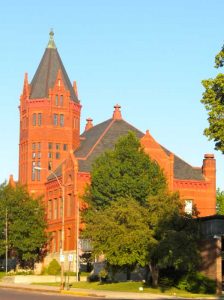
Marshall County, Kansas
Towns & Places
Bremen – Unincorporated
Herkimer– Unincorporated
Home – Unincorporated
Lillis – Unincorporated
Marysville – County Seat
Vliets – Unincorporated
Tuttle Creek Lake and State Park
One of the original 33 counties created by the first Territorial Legislature, Marshall County is located in northeast Kansas, and Marysville is its county seat.
Rich in history, Marshall County was, for years, a vast prairie covered with a waving sea of wild grasses and large herds of buffalo that for centuries had wandered almost unmolested across them. Nothing disturbed the solitude save an occasional band of Indians searching for prey or the hardy frontiersman who is always found far in advance of the onward march of civilization. The first known white men to visit the area were the explorers of Stephen Long’s Expedition, who passed through the area in 1819 and 1820 on their way from Pittsburgh, Pennsylvania, to the Rocky Mountains. General John C. Fremont led a similar expedition through what is now Marshall County in the early 1840s, and in 1847, Joseph Smith, the Mormon Apostle, with his band of followers from Illinois, opened a permanent trail crossing the Big Blue River six miles below the present-day city of Marysville. The spot was afterward called “Mormon” as it became a regular camping place for Mormon people who crossed the plains by the thousands in the next two years. In 1849, California gold hunters used this trail, and the place was called “California Crossing.” Later it was known as Independence Crossing.
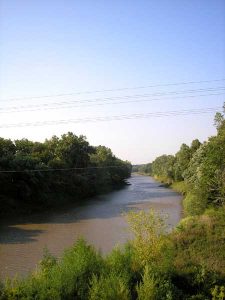
Big Blue River near Marysville, Kansas, by Kathy Alexander.
At this popular crossing, the first settler, A.G. Woodward, made his home in 1848. The next year, the Military Route from Fort Leavenworth to the Great Salt Lake was surveyed, which located a more practical crossing of the Big Blue River, about six miles above the old ford.
The same year, amid the California Gold Rush, Francis J. Marshall, from Weston, Missouri, established a ferry on the Big Blue River at the original crossing, then called the Independence Crossing. During the travel season, he remained there but returned to Missouri every winter. In the spring of 1851, he moved his ferry to the upper crossing in what is today Marysville, Kansas.
Until 1854, Marshal continued to spend his winters in Missouri, but each spring, he would return to operate his ferry. He also built a row of rude log cabins, established a blacksmith shop, and opened a small general store. In addition to minimal supplies, he also stocked low-grade tobacco and whiskey, which he traded with the Indians.
In the spring of 1854, James McCloskey, a Scotchman by birth, who had been an Indian trader among the Sioux on the Upper Platte River since 1839 and who had adopted the Indian habits, “came in this country with a half dozen other traders and their families, and decided to settle. Francis J. Marshall invited the party to settle in Marysville. They also received an urgent invitation from Louis Tremble, a Potawatomie half-breed, who had previously located a short time on the Vermillion River at “Independence Crossing,” where he maintained a toll bridge near him. McCloskey and his family settled on the Big Blue River near Marysville, while the balance of the party settled on the Vermillion River.
More settlements were made in the southeastern part of the county on the banks of the Vermillion River early in the spring of 1855. Among the first was John D. Wells, who would later become one of the first County Commissioners, and his family from Kentucky, who took up a claim near the old town of Barrett. A. G. Barrett, who would later become the County Treasurer, settled in the same vicinity in May 1855. More came the same year to the vicinity, including the Brockmeyer brothers, Joseph Langdon, Thomas Warren, H. Ashdown, and the Farley brothers. These intrepid settlers and others formed the nucleus of pioneers who were foremost in the advancement of the county.
The county was organized in 1855, and the county seat was established at Marysville. The first election was held on March 30, 1855, and proved to be an interesting event. The Kansas-Nebraska Act, which provided for the organization of the territory, gave voting rights to every “inhabitant” of the territory, but there was no required period of residence. Taking advantage of this loophole, thousands of Missourians came into the territory to vote, including several hundred men who came in wagons with camping equipment, stayed long enough to vote, and then left.
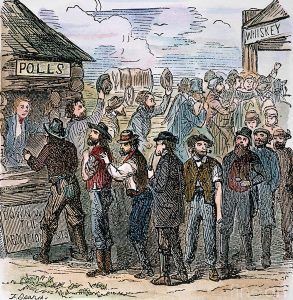
Voting in Kansas
The polling place was in the loft of F. J. Marshall’s store. The voter would go up a stairway far enough for the clerks and judges to see his head, call out a name, deposit his ballot, go back down, absorb some bad whiskey, think up another name, and repeat the process. It is said that Jonathan “Shanghai” Lang of Vermillion, after voting all day long between drinks, sprang upon a whiskey barrel and offered to bet $100 that he had outvoted anybody in the crowd. The challenge was accepted, and the money was put up. The “investigating committee” found that “Shanghai” had lost the bet, the winning party having deposited nearly 100 votes. It is said that this man had a St. Louis city directory in his possession and had voted halfway through the “A” list. As a result, Marysville, which consisted of only three or four log cabins at the time, had about 1,000 votes. In the meantime, Francis J. Marshall was elected a member of the Territorial Legislature.
The first Probate Judge of Marshall County was James Doniphan, who held the first term of court on October 10, 1855. Alexander Clark was the first sheriff, receiving his commission in October 1855, but was killed the next June while attempting to arrest two horse thieves.
In 1856, a colony of 85 South Carolina men was organized at Atchison, Kansas, the Palmetto Town Company. They soon traveled to Marshall County, where the site of the old ferry at Independence Crossing was purchased from Francis J. Marshall for $500, and a town was laid out called Palmetto. At about the same time, Francis J. Marshall laid out a town around his trading post and ferry, which he called Marysville, after his wife. The two communities were at variance for the next two years, and in some cases, their quarrels were settled with pistols. At last, Marshall induced the South Carolinians to move their town up the river to Marysville. Settlers continued to arrive in the next few years, forming Beattie, Irving, Blue Rapids, Lane’s Ford, Frankfort, and others.
The first newspaper established in the county was the Palmetto Kansan, owned by the Palmetto Town Company and edited by J. E. Clardy in 1857. The first school was taught in Marysville in 1859.
As with nearly every county, Marshall had a county seat contest. The Territorial Legislature placed it at Marysville in 1855. Still, in 1859, T.S. Vaile, a member of the Free-State Legislature, had the county seat changed to a new “town” named Sylvan, as Marysville was reputed to be a pro-slavery town at the time. However, by a vote of the people, it was taken back to Marysville. By 1860, the population was 2,280, well distributed over the county.
When the Civil War broke out in the spring of 1861, the War Department made Marysville the recruiting station for Washington and Marshall counties, which raised three full companies. Out of 450 voters, Marshall County furnished 431 men for the Union army. At that time, Marshall County was, at times, the seat of panic arising from Indian depredations. Emigrants, Frenchmen, and settlers who had ventured farther west were often driven into the county. There was some fear that the older settlements would be attacked while depleted of able-bodied fighters. In 1862, a raid was made into Washington County, to which a detachment of soldiers was sent out, but no Indians were seen. In 1864, an Indian raid was made on the Little Blue River. On August 10th, refugees began arriving at Marysville in wagons, each party telling of terrible outrages and tortures of those captured. The next day, two companies were sent out after the attackers but returned without finding the Indians.
In 1862, the congregation of the Southern Methodist Church, which had been built in the spring of 1860, could not make their payments, and the building was foreclosed on and moved to Broadway Street in Marysville. In July, the building was sold to the county to use as a courthouse, as before this time, the county offices were spread all over town.
During this time, domestic trouble was also taking place at what was known as the “Oketo Cutoff.” In 1863, the Overland Stage Route came by Guittard Station through Marysville. For some reason, the proprietor of the stage line did not like Marysville and proposed to change the route to go through Oketo. Accordingly, he built the “cutoff” at great expense, and in October 1862, the stage began traveling that route, leaving Marysville several miles to the south. This was bad for the town, for it diverted travel and delayed the mail so that it was sometimes a month behind its regular schedule. This precipitated a sort of neighborhood struggle in which no one was killed, but many tricks were played by both sides, some of which were destructive to property. At one time, the United States troops were called out from Fort Leavenworth to protect the stage line. After losing some $50,000 by the cut-off, the proprietor of the stage line changed the route back to Marysville in March 1863.
The first train came into Marshall County over the St. Joseph & Western Railroad, which was begun in 1860 and reached the eastern limits of Marshall County in 1870. The following year it was extended to Marysville. Over the following years, more railroads would be added to the county until ample transportation and shipping points could be found in several locations.
In August 1867, Marshall County suffered its first grasshopper plague, when the insects attacked nearly every growing thing, leaving destroyed crops and devastation in their wake. They returned the following year in August, and though they remained for three days, they did little damage.
In 1871, the county seat location was again contested, and several settlements were placed before the people for a vote, including Waterville, Blue Rapids, Frankfort, and Marysville. The election resulted once again in favor of Marysville. The number of votes cast would indicate between 13,000 and 14,000 people in the county.
In February 1873, the county awarded a contract to build a new county courthouse, completed in July 1874.
In the summer of 1874, the grasshoppers again appeared in the county and commenced their ravages on corn and other products, and soon everything was destroyed. The green foliage on the trees and bushes was next attacked and was soon stripped. After eating every green thing, they departed for realms unknown.
Still, the farmers hanged on, but the county would see calamity again on May 30, 1879, when a tornado ripped through the area, venting its fury on Irving, Frankfort, and Waterville. The F4 tornado had a damaged path of 800 yards wide and 100 miles long.
When it was over, about 40 buildings were destroyed in Irving, about a dozen people were killed and several injured; in Waterville, some 50 structures were damaged, though there was no loss of life; and at Frankfort, five people were killed, about 50 wounded, and much property damage occurred.
By the turn of the century, the county’s population peaked at more than 24,000 people, with its primary economy farming corn, wheat, other grains, and potatoes. Considerable livestock was also raised and shipped.
Over the next century, Marshall County diversified its industries but continued to have a primary economic basis of agriculture. Like other Kansas counties whose people depended chiefly on farming and ranching, the population has gradually declined. Its population peaked at 23,056 in 1930 and has fallen every decade, and today, the county supports just about 9700 people.
Marshall County’s rich history of the Oregon and Mormon Trails, the short-lived Pony Express, and pioneer settlements can still be seen at several historic sites and museums.
©Kathy Alexander/Legends of Kansas, updated October 2023.
Also See:
Sources:
Blackmar, Frank W.; Kansas: A Cyclopedia of State History, Vol I; Standard Publishing Company, Chicago, IL 1912.
Cutler, William G; History of Kansas; A. T. Andreas, Chicago, IL, 1883.
Forter, Emma Elizabeth Calderhead; History of Marshall County, Kansas: Its People, Industries, and Institutions; B.F. Bowen, 1917.
Wikipedia

